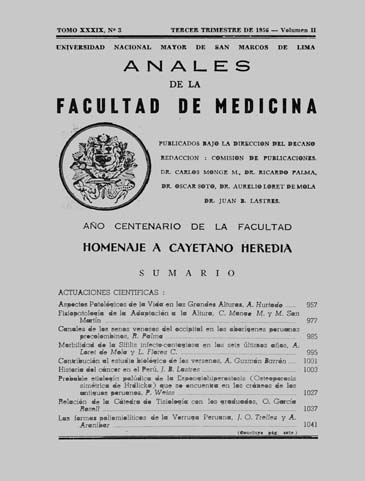Comparative study of mountain sickness
DOI:
https://doi.org/10.15381/anales.v39i3.10833Abstract
In order to make a comparative study of Mountain Sickness affecting humans and cattle and sheep has been reviewed briefly the clinical, hematologic and pathologic aspects found in the literature. The anatomic correlation of clinical symptoms and major injuries in the bovine and ovine, emphasizing, among other things, the similarity of symptoms and lesions observed in the myocardium and the adrenal cortex does. Mountain Sickness In the three species considered in this study polycythemia is one of the most important manifestations. However. emphasizes that the normal height ram no modifications CBC as those seen in man and in normal cattle. The hipotocoferolemia is noted as a factor that may explain the transient polycythemia has been observed in normal lambs and is associated with myocardial lesions observed in the Mountain Sickness affecting this species. Hypertrophy and hyperplasia of the adrenal cortex in the syndrome of adaptation to high altitude and severe injuries of the same as an explanation for the progressive and fatal outcome in some cases of Mountain Sickness in cattle and sheep is noted.Downloads
Published
1956-09-28
Issue
Section
Trabajos originales
License
Copyright (c) 1956 Alberto Cuba Caparó

This work is licensed under a Creative Commons Attribution-NonCommercial-ShareAlike 4.0 International License.
Those authors who have publications with this magazine accept the following terms:
- Authors will retain their copyrights and guarantee the journal the right of first publication of their work, which will be simultaneously subject to Creative Commons Attribution License that allows third parties to share the work as long as its author and its first publication this magazine are indicated.
- Authors may adopt other non-exclusive licensing agreements for the distribution of the version of the published work (eg, deposit it in an institutional electronic file or publish it in a monographic volume) provided that the initial publication in this magazine is indicated.
- Authors are allowed and recommended to disseminate their work over the Internet (eg: in institutional telematic archives or on their website) before and during the submission process, which It can produce interesting exchanges and increase quotes from the published work. (See El efecto del acceso abierto ).
How to Cite
1.
Cuba Caparó A. Comparative study of mountain sickness. An Fac med [Internet]. 1956 Sep. 28 [cited 2025 Jun. 4];39(3):1104-27. Available from: https://revistasinvestigacion.unmsm.edu.pe/index.php/anales/article/view/10833



